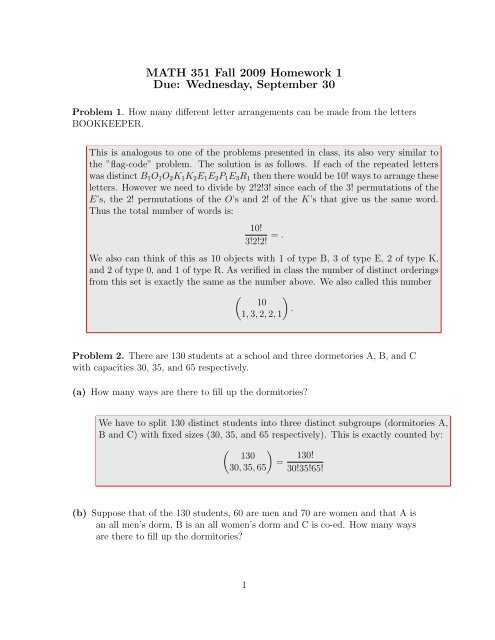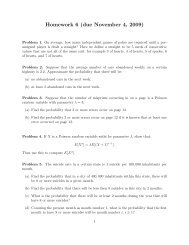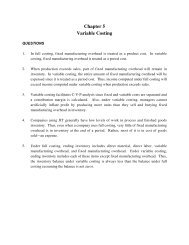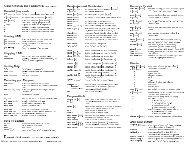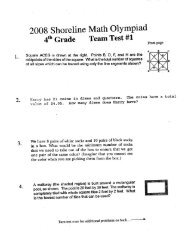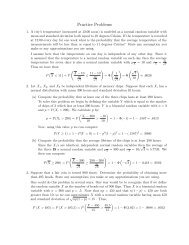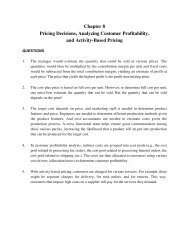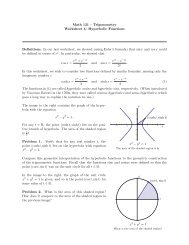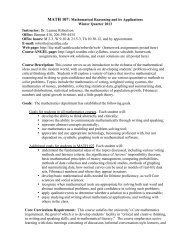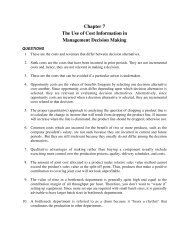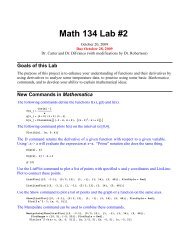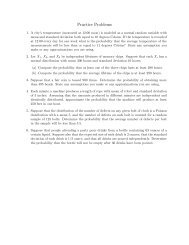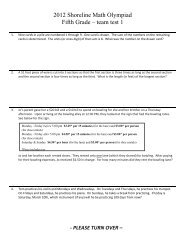MATH 351 Fall 2009 Homework 1 Due: Wednesday, September 30
MATH 351 Fall 2009 Homework 1 Due: Wednesday, September 30
MATH 351 Fall 2009 Homework 1 Due: Wednesday, September 30
Create successful ePaper yourself
Turn your PDF publications into a flip-book with our unique Google optimized e-Paper software.
<strong>MATH</strong> <strong>351</strong> <strong>Fall</strong> <strong>2009</strong> <strong>Homework</strong> 1<br />
<strong>Due</strong>: <strong>Wednesday</strong>, <strong>September</strong> <strong>30</strong><br />
Problem 1. How many different letter arrangements can be made from the letters<br />
BOOKKEEPER.<br />
This is analogous to one of the problems presented in class, its also very similar to<br />
the ”flag-code” problem. The solution is as follows. If each of the repeated letters<br />
was distinct B 1 O 1 O 2 K 1 K 2 E 1 E 2 P 1 E 3 R 1 then there would be 10! ways to arrange these<br />
letters. However we need to divide by 2!2!3! since each of the 3! permutations of the<br />
E’s, the 2! permutations of the O’s and 2! of the K’s that give us the same word.<br />
Thus the total number of words is:<br />
10!<br />
3!2!2! = .<br />
We also can think of this as 10 objects with 1 of type B, 3 of type E, 2 of type K,<br />
and 2 of type 0, and 1 of type R. As verified in class the number of distinct orderings<br />
from this set is exactly the same as the number above. We also called this number<br />
( )<br />
10<br />
.<br />
1, 3, 2, 2, 1<br />
Problem 2. There are 1<strong>30</strong> students at a school and three dormetories A, B, and C<br />
with capacities <strong>30</strong>, 35, and 65 respectively.<br />
(a) How many ways are there to fill up the dormitories?<br />
We have to split 1<strong>30</strong> distinct students into three distinct subgroups (dormitories A,<br />
B and C) with fixed sizes (<strong>30</strong>, 35, and 65 respectively). This is exactly counted by:<br />
( ) 1<strong>30</strong><br />
= 1<strong>30</strong>!<br />
<strong>30</strong>, 35, 65 <strong>30</strong>!35!65!<br />
(b) Suppose that of the 1<strong>30</strong> students, 60 are men and 70 are women and that A is<br />
an all men’s dorm, B is an all women’s dorm and C is co-ed. How many ways<br />
are there to fill up the dormitories?<br />
1
( ) 60<br />
To count this, first choose the <strong>30</strong> men for dorm A from the 60 possible men by .<br />
(<br />
<strong>30</strong><br />
) 70<br />
Second choose the 35 women from the 70 women, that will go into dorm B by .<br />
35<br />
The remainder will then be in dorm C. By the basic principle of counting the total<br />
possible placings of the students is the product:<br />
( ) ( ) 60 70 60!70!<br />
=<br />
<strong>30</strong> 35 <strong>30</strong>!<strong>30</strong>!35!35! .<br />
Problem 3. In how many ways can ten people be seated in a row if:<br />
(a) there are no restrictions on the seating arrangement?<br />
This is a simple permutation of 10 distinct objects. Thus the solution is 10! =.<br />
(b) persons A and B must sit next to each other?<br />
If A and B must sit together we treat them as one ”person” and order them with the<br />
remaining 8 people in 9! different ways. Then for each of those orderings we either<br />
have A first or B first or 2 possible arrangements. By the basic counting principle we<br />
have a total of 2 × 9! = orderings.<br />
(c) there are 5 men and 5 women, and no 2 men or 2 women can sit next to each<br />
other?<br />
First choose if they sit mwmwmwmwmw or wmwmwmwmwm. Once this is chosen<br />
then order the men in their seats. Since there are five of them there are 5! arrangements.<br />
Similarly the women can then be seated in 5! different ways. Thus the total<br />
number of arrangements is 2 × 5! × 5! =.<br />
(d) there are 5 men and they must sit next to each other?<br />
2
If the 5 men must sit next to each other then if the seates are ordered #1 − #10<br />
then the first man can be in seat #1 − #6. Choose this seat (6 ways). Then order<br />
the 5 men (5!). Then order the 5 women in the remaining seats (5!). Thus the total<br />
number of orderings is 6 × 5! × 5! =.<br />
(e) there are 5 married couples, and each couple must sit together?<br />
To count this treat each couple as an object and order them in 5! ways. Then once<br />
their two seats are chosen there are 2 ways the first couple can sit (mw or wm). Then<br />
there are 2 ways in which the second couple can sit and so forth. Giving a total of<br />
5!2 5 = arrangements of the people.<br />
Problem 4.<br />
properties?<br />
How many integers greater then 5400 have both of the following<br />
(a) The digits are distinct.<br />
(b) The digits 2 and 7 do not occur.<br />
To do this problem we split it into cases. First consider the numbers with 8 digits.<br />
in this case we must order the digits 1, 3, 4, 5, 6, 8, 9, and 0. However when we pick<br />
the digit for the first entry we only have 7 choices since 0 cannot be the first digit.<br />
Then once we have chosen that digit we have to order the remaining 7 digits in any of<br />
the 7! possible permutations. Thus the total number is 7 × 7! = 35280. In a similar<br />
fashion there are 7 × 7! = 35280 seven digit numbers, 7 × 7 × 6 × 5 × 4 × 3 = 17640<br />
six digit numbers of this type and 7 × 7 × 6 × 5 × 4 = 5880 five digit numbers. The<br />
four digit numbers must be handled in cases since they must be bigger then 5400.<br />
First count the numbers that are 6000 or bigger. To do this there are 3 choices for<br />
the first digit (6,8, or 9) then 7 choices for the second, 6 for the third, and 5 for the<br />
fourth position, giving 3 × 7 × 6 × 5 = 6<strong>30</strong> numbers of this type. Secondly consider<br />
the numbers that begin with a 5. Then there are four choices for the second digit<br />
(4,6, 8, or 9 ) that can be picked for the second digit. Then the third digit must be<br />
chosen from the remaining 6 digits and then there are 5 choices for the fourth digit<br />
Giving 4×6 = 120 numbers of this type. Thus the total number of integers satisfying<br />
conditions (a) and (b) is 120 + 6<strong>30</strong> + 5880 + 17640 + 35280 + 35280 = 948<strong>30</strong>.<br />
3
Problem 5.<br />
(a) Suppose that Michigan table tennis team of 16 players splits into pairs for<br />
practicing. How many different splittings are possible?<br />
One way to think of this is that you have to take 16 people and envision placing two<br />
at each of 8 tables numbered 1-8. This is splitting 16 people into 8 distinct groups of<br />
2 people each. The number of ways to do this is:<br />
(<br />
)<br />
16<br />
=<br />
2, 2, 2, 2, 2, 2, 2, 2<br />
16!<br />
2!2!2!2!2!2!2!2! .<br />
However we have over counted since if Ms A and Mr. B are at table one or at table<br />
2 makes no difference. Thus we must divide by 8!. Giving pairings.<br />
(b) Suppose that Michigan table tennis team of 12 players competes with MSU<br />
team of 12 players. How many different splittings are possible (each pair<br />
contains a player of each team)?<br />
This is actually easy to count because we envision the Michigan players lined up.<br />
Then we start with the first one in line and pick a MSU player to be paired with him.<br />
There are 12 ways to do this. Next we go to the second Michigan player and we have<br />
11 possible choices of MSU players to play him, and so on. So a total of 12! possible<br />
pairing are possible.<br />
Problem 6. A classroom has 2 rows of 8 seats each. There are 14 students, 5 of<br />
whom always sit in the front row and 4 of whom always sit in the back row. In how<br />
many ways can the students be seated?<br />
Consider the probblem by breaking it into pieces. First suppose the ”back-row sitters”<br />
walk into the room. Then there are 8 choices of where the first one to walk in can sit.<br />
7 for the second, 6 for the third and 5 for the fourth. Next the ”front-row-sitters”<br />
walk in. There are 8 choices for the first 7 for the second, ...4 for the 5th. Now the<br />
five remaining students walk in one at a time. There are 7 seats remaining and the<br />
first of these students that walks in has 7 choices of where to sit, the second has six<br />
choices, .... the fifth has 3 choices of where to sit. Viewing the problem in this way<br />
tells us that the answer should be:<br />
(8 · 7 · 6 · 5)(8 · 7 · 6 · 5 · 4·)(7 · 6 · 5 · 4 · 3·) = 28449792000<br />
4
Problem 7. From a group of 8 women and 6 men a committee consisting of 3 men<br />
and 3 women is to be formed. How many dierent committees are possible if:<br />
(a) 2 of the men (Mr. X and Mr. Y) refuse to serve together;<br />
We count this by first considering all the possible committees with out any restriction<br />
and then subtracting the number of committees ( with Mr. A and Mr. B. The total<br />
6<br />
number of ways to choose 3 men from 6 is and the total ways of choosing 3<br />
(<br />
3)<br />
8<br />
women from 8 is . Thus the total number of committees with 3 men and 3<br />
3)<br />
( ) ( 6 8<br />
women is the product = 1120. Now if we count the number of committees<br />
3 3)<br />
that have both ( Mr. A and Mr. B then we must choose the one ( remaining man from<br />
4 8<br />
the other 4 or and then choose the 3 women from 8 . Giving a total of<br />
(<br />
1)<br />
3)<br />
8<br />
4 · = 224. Thus subtracting the two gives 1120 − 224 = 896. (Note one could do<br />
3)<br />
this problem by considering the possible committees with neither A nor B and then<br />
as a separate case consider the committees with exactly one of A or B and then add<br />
the cases together)<br />
(b) 2 of the women (Ms. A and Ms. B) refuse to serve together;<br />
This proceeds in an analogous fashion to part (a) and we subtract the committees<br />
with both Ms. A and Ms. B from the total (1120 as counted in part (a)). The number<br />
of ( ways that Ms. A and Ms B can serve together is by first choosing ( the three men<br />
6 6<br />
and then choosing one more woman from the other 6 or = 6. Thus the<br />
3)<br />
(<br />
1)<br />
6<br />
total number of committees with both Ms. A and Ms. B is 6 · = 120. Thus, the<br />
3)<br />
total number of committees when they DO NOT serve together is 1120 − 120 = 1000.<br />
(c) 1 man (Mr. X) and 1 woman (Ms. A) refuse to serve together?<br />
5
Again we proceed in a similar fashion and count the committees when Mr. X and Ms.<br />
A serve ( together. To do this we first choose the 2 other men from the remaining ( 5,<br />
5 7<br />
or = 10 and then choose the other 2 women from the remaining 7 or = 21.<br />
2)<br />
2)<br />
Thus the total number of ways in which they can serve together is the product of<br />
these two numbers of 210. Now the total number of committees in which they do not<br />
serve together is our total number of committees with no restrictions (1120) minus<br />
the committees where they do serve together (210). Thus the answer is 910.<br />
Problem 8. Let r, n, and m be positive integers, and let r < n and r < m. Then<br />
the following identity holds:<br />
( ) n + m<br />
=<br />
r<br />
r∑<br />
( ) ( ) n m<br />
.<br />
i r − i<br />
i=0<br />
Prove it combinatorially by considering a group of n men and m women, and determining<br />
(in two different ways) how many groups of size r are possible.<br />
To prove this we follow the suggestion and consider a group of n men and m women,<br />
and count the number of committees of r people we can choose from the total (n+m)<br />
people. Clearly one way to count this is the left hand side (LHS) of the equation we<br />
wish to verify.<br />
Now consider counting the same thing but breaking it into cases were we consider<br />
the committees that have no men, exactly 1 man, exactly 2 men, ...., all r are men.<br />
To do this consider the arbitrary case where there are i men in the( committee ) and r-i<br />
n<br />
women. Thus we must choose the i men from the total n men or and we must<br />
( )<br />
i<br />
m<br />
choose the r-i women from the total m women or Thus the total number of<br />
r − i<br />
committees ( ) ( ) with r people with i of them men and r-i of them women is the product,<br />
n m<br />
. Now since we want to count all the possible committees we must add<br />
i r − i<br />
all the cases where i = 0, i = 1, ....i = r. This is exactly the right hand side of the<br />
equation we wish to verify.<br />
Since both the left and the right hand side count the same thing, they must be equal.<br />
Problem 9. In the expansion of (z + 8y) 7 , what is the coefficient of z 4 y 3 ?<br />
6
Recall the binomial theorem:<br />
(a + b) n =<br />
n∑<br />
i=0<br />
( n<br />
i<br />
)<br />
a i b n−i .<br />
Using this,<br />
(z + 8y) 7 =<br />
7∑<br />
i=0<br />
( 7<br />
i)<br />
z i (8y) 7−i .<br />
If I want the coefficient of z 4 y 3 then i must consider the term<br />
( 7<br />
coefficient of that term is (8)<br />
4)<br />
3 = 17920<br />
( 7<br />
4)<br />
z 4 (8y) 3 . Thus the<br />
Problem 10. There are 12 people to attend a dinner party and sit at a round table.<br />
(a) How many ways can these 12 people be arranged at the table? ( supposing that<br />
any seating arangement is equivalent to another if they are rotations of each<br />
other)<br />
Since any arrangement of the people at the table can be rotated so that a certain<br />
distinguished person (call him Bob) is sitting at the head of the table. We can count<br />
just the arrangements where Bob is sitting at the top of the table. To do this we<br />
order the remaining 11 people around the table in 11! ways.<br />
(b) Suppose there are 6 men and 6 women, How many seating arrangements are<br />
there if no two men are to sit together.<br />
In the same fashion we suppose Bob is sitting at the top. Then the person sitting to<br />
he left must be a woman and there are 6 choices for that seat. Then we go the her<br />
left and there must be a man (other then bob so there are 5 choices for this seat. We<br />
continue around the table giving a total of 6! · 5! = 86400 arrangements around the<br />
table.<br />
(c) How many arrangements are there if the host and the hostess are to sit opposite<br />
eachother, but the rest of the guests may sit anywhere?<br />
7
Again we proceed in the same fashion and suppose that the Host is at 12 o’clock and<br />
that the hostess is seated at 6 o’clock. Thus we must just order the remaining 10<br />
people and there are 10! = 3628800 ways to do so.<br />
Problem 11 How many integer solutions of:<br />
x 1 + x 2 + x 3 + x 4 = <strong>30</strong><br />
satisfy, x 1 ≥ 2, x 2 ≥ 0, x 3 ≥ −5, and x 4 ≥ 8?<br />
To solve this problem we re-scale the variables by letting y 1 = x 1 − 2, y 2 = x 2 ,<br />
y 3 = x 3 + 5, and y 4 = x 4 − 8. Solving for each x i and substituting into the equation<br />
above we obtain:<br />
(y 1 + 2) + y 2 + (y 3 − 5) + (y 4 + 8) = <strong>30</strong>,<br />
where each y i is now greater then or equal to 0. Manipulating the constants gives us:<br />
y 1 + y 2 + y 3 + y 4 = 25<br />
. As per definition in class, the number of integer solutions to this equation is given<br />
by: ( ) ( )<br />
25 + 4 − 1 28 28 · 27 · 26<br />
= = = 3276.<br />
4 − 1 3 3!<br />
8


